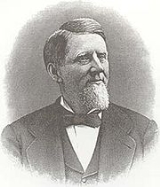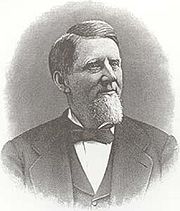
John H. Starin
Encyclopedia

United States House of Representatives
The United States House of Representatives is one of the two Houses of the United States Congress, the bicameral legislature which also includes the Senate.The composition and powers of the House are established in Article One of the Constitution...
from New York
New York
New York is a state in the Northeastern region of the United States. It is the nation's third most populous state. New York is bordered by New Jersey and Pennsylvania to the south, and by Connecticut, Massachusetts and Vermont to the east...
, grandson of Thomas Sammons
Thomas Sammons
Thomas Sammons was a United States Representative from New York. Born in Shamenkop, Ulster County, he attended the rural schools, served as an officer in the Revolutionary War, and engaged in agricultural pursuits...
. Born in Sammonsville, Fulton County (then a part of Montgomery County), New York. Starin pursued academic studies in Esperance, New York, where he began the study of medicine in 1842. He established and operated a drug and medicine business in Fultonville
Fultonville, New York
Fultonville is a village in Montgomery County, New York, United States. The population was 710 at the 2000 census. The village is named after Robert Fulton, inventor of the steamboat....
from 1845–1858. From 1848 – 1852 he also served as Postmaster of Fultonville
Fultonville, New York
Fultonville is a village in Montgomery County, New York, United States. The population was 710 at the 2000 census. The village is named after Robert Fulton, inventor of the steamboat....
. Starin was the founder and president of the Starin City River & Harbor Transportation Co. and served as director of the North River Bank, in New York City
New York City
New York is the most populous city in the United States and the center of the New York Metropolitan Area, one of the most populous metropolitan areas in the world. New York exerts a significant impact upon global commerce, finance, media, art, fashion, research, technology, education, and...
, and the Mohawk River National Bank. He was also interested in agriculture and stock raising.
Starin was elected as a Republican
Republican Party (United States)
The Republican Party is one of the two major contemporary political parties in the United States, along with the Democratic Party. Founded by anti-slavery expansion activists in 1854, it is often called the GOP . The party's platform generally reflects American conservatism in the U.S...
to the Forty-fifth
45th United States Congress
-House of Representatives:-Leadership:-Senate:*President: William A. Wheeler *President pro tempore: Thomas W. Ferry -House of Representatives:*Speaker: Samuel J. Randall -Members:This list is arranged by chamber, then by state...
and Forty-sixth
46th United States Congress
The Forty-sixth United States Congress was a meeting of the legislative branch of the United States federal government, consisting of the United States Senate and the United States House of Representatives. It met in Washington, D.C. from March 4, 1879 to March 4, 1881, during the last two years of...
Congresses (March 4, 1877 – March 3, 1881).
From 1883 – 1909 he served as president of Fultonville National Bank. He engaged in railroading and served as member of the New York City Rapid Transit Commission as well.
Starin died in New York City March 21, 1909 and was interred in the Starin mausoleum in Fultonville Cemetery
Fultonville Cemetery
Old Fultonville Cemetery, also known as the Old Village Cemetery or the Protestant Dutch Church Burying Ground, is a modestly sized municipal cemetery in Fultonville, New York. The cemetery was originally the burying ground for the Protestant Dutch Church of Fultonville, but was transferred to the...
, Fultonville, New York
Fultonville, New York
Fultonville is a village in Montgomery County, New York, United States. The population was 710 at the 2000 census. The village is named after Robert Fulton, inventor of the steamboat....
.
Glen Island
In 1878 Starin purchased a series of small islands off the coast of New Rochelle, New YorkNew Rochelle, New York
New Rochelle is a city in Westchester County, New York, United States, in the southeastern portion of the state.The town was settled by refugee Huguenots in 1688 who were fleeing persecution in France...
which he turned into an amusement park by the name of Glen Island. He maintained the islands as a select summer resort, operating 12 steamboats to and from New York City
New York City
New York is the most populous city in the United States and the center of the New York Metropolitan Area, one of the most populous metropolitan areas in the world. New York exerts a significant impact upon global commerce, finance, media, art, fashion, research, technology, education, and...
. The islands were so popular that hundreds of thousands of visitors were brought every season to the attractions which included a zoo, a natural history museum, a railway, a German beer garden (around the castle-like structure which still stands today), a bathing beach, and a Chinese pagoda. A chain ferry transported visitors from a mainland dock. By 1882 attendance reached half a million and within six years it broke a million. In spite of the large number of visitors, Starin stressed the well-behaved nature of the crowds and the orderly character of the experience, governed by a 'middle-class code of conduct'. His desire was to offer an environment of order and civility which contrasted to the rough-and-tumble atmosphere of New York City
New York City
New York is the most populous city in the United States and the center of the New York Metropolitan Area, one of the most populous metropolitan areas in the world. New York exerts a significant impact upon global commerce, finance, media, art, fashion, research, technology, education, and...
. One of the effects of Glen Islands popularity in the beginning of the twentieth century was the building boom in New Rochelle, which had rapidly grown into a summer resort community.
The Starin Mausoleum

Fultonville Cemetery
Old Fultonville Cemetery, also known as the Old Village Cemetery or the Protestant Dutch Church Burying Ground, is a modestly sized municipal cemetery in Fultonville, New York. The cemetery was originally the burying ground for the Protestant Dutch Church of Fultonville, but was transferred to the...
around 1886. The building was approximately 45 feet tall, 25 feet across, and 15 feet deep. The Starin mausoleum no longer stands in the Old Fultonville Cemetery, yet remnants of the foundation can still be found. When John H. Starin died in 1909, he left a sum of money to the village of Fultonville to take care of the mausoleum. In the 1970s the mausoleum began to fall into disrepair. Sometime around this time, it was also vandalized on Halloween by a group of teenagers, who destroyed most of the caskets and bodies. In the summer of 1975 the mausoleum was taken down and the remains that were left in the mausoleum were re-interred in front of where it once stood and markers were placed on the graves. At the point of the demolition, which Jake Stevens headed, there was very little left to the mausoleum. Today, a modest upright granite slab with a bronze face marks his grave as well as his family member's graves.
Source
Glen Island 1Glen Island 2
Glen Island 3

